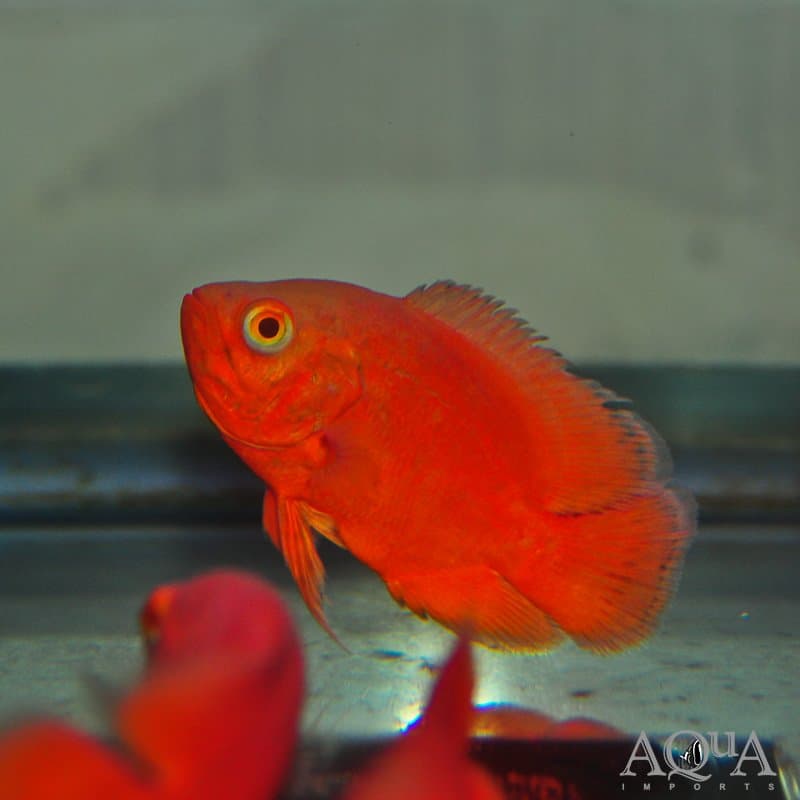The Red Tiger Oscar Fish is a vibrant and captivating species that adds drama and color to any freshwater aquarium. Known for its unique marbled patterns of red and orange against a black background, the Red Tiger Oscar is a popular choice amongst aquarists. With their engaging personalities and pronounced intelligence, Oscars are often described as one of the most personable fish to keep, capable of recognizing their owners and interacting with them.
Caring for these fish requires understanding their natural habitat and behaviors. Oscars originate from the Amazon Basin in South America and are accustomed to warm, slow-moving waters. They are a type of cichlid, growing to be quite large and therefore demanding spacious tanks to accommodate their size. Their natural behaviors highlight the need for aquarists to provide a suitable environment that includes adequate space, filtration, and a proper diet to maintain their health and vitality.
Key Takeaways
- Red Tiger Oscars are colorful freshwater fish with unique personalities.
- They require large tanks and specific water conditions to thrive.
- Oscars need interactive care and are prone to specific diseases.
Natural Origin and Species Information
In this section, we provide detailed insights into the scientific classification and the natural environments where the Red Tiger Oscar fish originate. These subsections will explore both the taxonomy and the typical habitats of this vibrant cichlid.
History and Scientific Classification
The Red Tiger Oscar, scientifically named Astronotus ocellatus, is a member of the cichlid family that we know for its bold personality and striking appearance. We classify it under:
- Kingdom: Animalia
- Phylum: Chordata
- Class: Actinopterygii
- Order: Cichliformes
- Family: Cichlidae
- Genus: Astronotus
- Species: A. ocellatus
Originating from South America, the species was first described in 1831. While ‘Astronotus ocellatus’ refers to its scientific name, the common name, Tiger Oscar, stems from the fish’s tiger-like stripes and spots reminiscent of an ocelot pattern.
Natural Habitat and Geographic Distribution
The natural habitat of the Tiger Oscar consists of slow-moving water including rivers, canals, and floodplains, situated within the Amazon River Basin. The specifics of its distribution are:
- Continent: South America
- Regions: Primarily the Amazon River Basin
Living in tropical climates, the Tiger Oscar thrives in warm, freshwater ecosystems. Its distribution in the wild spans several countries where the Amazon Basin is present, assuring the fish’s familiarity with a diverse range of South American aquatic environments.
Physical Characteristics and Behavior
The Red Tiger Oscar Fish is a vibrant freshwater species known for its distinct appearance and dynamic behavior. We’ll explore these unique features in detail.
Appearance and Colors
The Red Tiger Oscar Fish boasts a captivating color palette that typically includes hues of red, orange, yellow, and black. Their bodies are often adorned with a mix of these colors, creating a contrast that’s visually appealing. Markings among these fish can vary significantly, with some individuals displaying prominent spots and others showcasing a more marbled pattern.
- Color Variations: Reds and oranges tend to dominate, while yellows can surface as highlights.
- Body Markings: Black spots and blotches are common, often accompanied by white edging.
The colors and patterns can shift over time and are influenced by factors such as diet and environment. This adaptive coloration helps them blend into their surroundings, reducing stress and the potential for aggression from other fish.
Behavioral Traits and Social Structure
Red Tiger Oscars demonstrate a range of behaviors that underscore their complexity as a species. They can be territorial and show aggression, especially during feeding times or when they feel their space is being invaded.
- Social Dynamics: They are not schooling fish, preferring to establish their own territory.
- Signs of Stress: Changes in behavior, such as increased aggression or hiding, can indicate stress.
Their behavior toward other fish can be unpredictable. While Oscars can coexist with other large fish, they are prone to asserting dominance, often leading to displays of territorial aggression. Introduction of tankmates should be done with caution to minimize conflicts.
Understanding and respecting their need for space will promote a healthier and less stressful environment for these magnificent fish.
Aquarium Care and Requirements

Proper care and maintenance of an aquarium are crucial for the health and well-being of Red Tiger Oscar Fish. We’ll cover important aspects such as tank setup, water conditions, and diet specifics to ensure a thriving environment.
Tank Setup and Conditions
For Red Tiger Oscars, a large aquarium is necessary due to their size. A minimum tank size of 55 gallons is recommended for one fish, with an additional 20-30 gallons for each additional Oscar to prevent territorial aggression.
- Substrate: A layer of sand or fine gravel should line the bottom.
- Rocks and Driftwood: Provide hiding places and mimic natural habitat.
- Plants: Hardier species are preferred, as Oscars may uproot delicate foliage.
Water Parameters and Filtration
Maintaining specific water parameters is vital to prevent health issues like ich.
- Temperature: Between 74-81°F (23-27°C).
- pH Levels: A range of 6.0 to 8.0 is ideal.
A robust filtration system is needed to handle the significant waste Oscars produce. We use both mechanical and biological filtration to keep the water clean and oxygenated. Regular water tests and changes of about 20% weekly are standard practice.
Feeding and Diet
Red Tiger Oscars are omnivores and require a varied diet.
- Base Diet: High-quality cichlid pellets as the staple.
- Live Foods: Supplement with live or frozen foods such as crickets, mealworms, and feeder fish for protein.
- Vegetables: Incorporate veggies, such as peas, to provide fiber.
Feeding should be done once or twice a day, offering only as much food as they can consume in a few minutes to maintain water quality.
Health and Common Diseases

Red Tiger Oscars are generally hardy fish, but like any species, they’re susceptible to certain health issues. By understanding how to prevent and identify diseases, we can ensure these vibrant fish live healthy lives.
Preventing and Identifying Ailments
Prevention is key to maintaining the health of Red Tiger Oscar fish. Strict tank hygiene, stable water conditions, and a balanced diet are fundamental. Stress is a common precursor to illness; therefore, minimizing stress by avoiding overcrowded tanks and maintaining a consistent environment is crucial.
To identify ailments early, we look for common signs such as changes in behavior or appearance. Illnesses like ich (white spot disease) present with small, white, granular lesions on the skin. Velvet, another parasitic disease, is indicated by a yellowish dust on the skin. Hole in the head disease, noticeable by lesions or depressions on the head, is often linked to dietary deficiencies or poor water quality. Observing these symptoms early allows for more effective treatment.
Treatment Methods
When disease is suspected, accurate diagnosis and prompt treatment are vital. For illnesses like ich, treatments include raising the tank temperature to speed up the parasite’s life cycle and administering copper-based medications or formalin baths. The choice of treatment depends on the specific conditions and the severity of the disease.
For fin rot, which typically results from bacterial infection, pristine water conditions combined with antibacterial medication can be effective. Advanced cases might require more aggressive treatments, like antibiotic injections.
In cases of velvet, a combination of dimming lights (as the parasite photosynthesizes) and the use of copper-based treatments can be employed. With hole in the head disease, improving water quality and diet, coupled with the administration of metronidazole, often leads to recovery.
It’s imperative for us to always quarantine new fish and monitor water quality regularly to keep these common diseases at bay.
Breeding and Lifecycle
Red Tiger Oscar Fish exhibit intriguing reproductive behaviors and require dedicated care for their offspring. Our understanding of their lifecycle is crucial for successful breeding.
Reproduction Behavior
The Red Tiger Oscar Fish is monomorphic, meaning males and females share similar appearances, which can make it challenging to distinguish between the sexes. We observe that breeding typically begins with a courtship ritual where pairs engage in a dance-like display. Spawning occurs when a female lays eggs on a flat surface, which are then fertilized by the male. A single spawning event can result in hundreds to thousands of eggs, adhering to the substrate.
Caring for Fry
Once the eggs hatch, the resulting fry require careful attention. Initially, they feed off their yolk sacs. After this stage, we must provide the fry with high-quality, specialized food to ensure proper growth. Both parents usually show protective behaviors, guiding and defending the fry. During this period, frequent water changes and close monitoring of water parameters are imperative to the survival of the young Oscars. Their lifespan can extend to up to 10-15 years with optimal care from this early stage onwards.
Tank Companions and Compatibility
We can ensure the well-being of Red Tiger Oscars by carefully selecting compatible tank mates and avoiding certain species that may lead to aggressive interactions.
Suitable Tank Mates
Silver Dollars and certain types of cichlids make suitable companions for Red Tiger Oscars due to their relatively peaceful nature and ability to coexist with larger, semi-aggressive fish. Specifically, we can consider the following tank mates:
- Silver Dollars (Metynnis sp.): These are schooling fish that require similar water parameters and are large enough not to be considered prey.
- Severum (Heros severus): Their calm demeanor makes them a good match for Tiger Oscars.
- Jack Dempseys (Rocio octofasciata): While they can have an assertive personality, they are generally compatible if given enough space.
Species to Avoid
Tiger Oscars, being a type of oscar cichlid, are known for their territorial and sometimes aggressive behavior, especially during feeding times or breeding. Consequently, there are certain fish and other aquatic creatures that we should avoid placing in the same tank:
- Small and timid fish: Tiny species can be seen as food by Tiger Oscars.
- Aggressive fish: More dominant fish may provoke the Oscars, leading to conflict. This includes overly aggressive cichlids like Convict Cichlids (Amatitlania nigrofasciata), which are known for their aggressive nature.
- Shrimp and other invertebrates: These are likely to become a quick snack for a hungry Oscar.
By selecting appropriate tank mates and avoiding problematic species, we help maintain a balanced and stress-free environment for Tiger Oscar fish.
Frequently Asked Questions
In this section, we will address some of the most common inquiries about the Red Tiger Oscar Fish, ranging from their habitat and care to their unique physical characteristics and dietary needs.
What is the typical habitat and care requirements for Red Tiger Oscar Fish?
Red Tiger Oscar Fish thrive in warm, freshwater environments and require a spacious tank with ample filtration. We recommend a minimum tank size of 55 gallons for one fish, with regular water changes to maintain water quality.
What are the distinguishing physical traits of Red Tiger Oscar Fish compared to other Oscar variants?
The Red Tiger Oscar Fish is recognized by its vibrant red and orange patterns against a darker backdrop. This variety has broader, jagged stripes compared to the cleaner bands or spots found in other Oscar species.
What is the average growth rate and adult size of Red Tiger Oscar Fish?
Red Tiger Oscars grow rapidly, often reaching their full size of up to 12-14 inches within two years. Juveniles grow about an inch per month under optimal conditions.
How can you differentiate between the various colors and patterns of Oscar Fish?
Oscar Fish exhibit a variety of colors and patterns, which include solid, marbled, or striped variations. Red Tiger Oscars are distinguished by intense red coloration and chaotic striping, whereas other varieties may present with different, more structured patterns and contrasts.
What are the best practices for feeding and nutrition in Red Tiger Oscar Fish care?
It’s essential to feed Red Tiger Oscars a varied diet consisting of high-quality pellets, live or frozen prey such as worms and insects, and occasional vegetables. Overfeeding should be avoided to prevent water pollution and health issues.
What is the scientific name and classification of Red Tiger Oscar Fish?
The scientific name of the Red Tiger Oscar Fish is Astronotus ocellatus. They belong to the cichlid family and are classified under the order Cichliformes.






